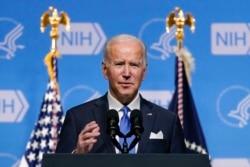United States health officials have reduced quarantine restrictions for Americans with the coronavirus who do not show signs of infection.
Individuals without signs of infection should isolate for five days, instead of 10, officials say. The health officials also shortened the time that those exposed to the virus should stay away from other people.
Officials from the Centers for Disease Control and Prevention announced the change on Monday. The agency said there is growing evidence that people with the coronavirus are most infectious in the two days before and three days after symptoms develop.
The decision was also driven by the large increase in COVID-19 cases because of the Omicron version, or variant, of the virus.
Early research suggests Omicron may cause less severe sickness than earlier versions of the new coronavirus. But the large number of people becoming infected and isolating themselves is hurting businesses, experts say.
Last week, the agency also changed rules for health care workers. Earlier, rules said that health care workers should stay away from work for 10 days if a test shows they are infected with the virus. The new guidelines say workers could go back to work after seven days if a test shows they do not have the virus and do not have symptoms.
On Monday, the CDC changed its isolation and quarantine guidance for the public. The change is aimed at people who are not experiencing symptoms. People who have symptoms during quarantine should stay home, the agency said.
Lindsay Wiley is a public health law expert at American University. She said the CDC’s quarantine guidance is confusing to the public. And the new recommendations are “happening at a time when more people are testing positive for the first time and looking for guidance.”
Isolation
The isolation rules are for people who are infected. They are the same for people who are unvaccinated, partly vaccinated, fully vaccinated or have the booster shot.
The rules say the quarantine starts the day of testing positive. An infected person should go into quarantine for five days, instead of 10.
At the end of five days, infected people may return to normal activities if there are no symptoms. But they must wear a mask everywhere for at least five more days. If there are still symptoms after five days, they should wait until symptoms improve before returning to normal activities.
Quarantine
The quarantine rules are for people who were in close contact with an infected person but not infected themselves.
A quarantine starts the day someone is told they may have been exposed to the virus.
Before, the CDC said people who were not fully vaccinated and who came in close contact with an infected person should stay home for at least 10 days. Now the agency says only people who get booster shots do not need to quarantine.
Five days
When people get infected, the risk of spread drops after five days, but it does not disappear for everyone, said Dr. Aaron Glatt. He is a spokesman for the Infectious Diseases Society of America.
“If you decrease it to five days, you're still going to have a small but significant number of people who are contagious,” he said.
That is why wearing masks remains an important part of the CDC guidance, officials said.
Not a mandate
The new CDC guidance is not a requirement. It is a recommendation to employers and state and local officials. Last week, New York state said it would expand on the CDC’s guidance for health care workers.
The change “is going to be perceived as coming in response to pressure from business interests,” Wiley said. But she said some experts have been calling for the changes for months.
I’m Dan Novak.
The Associated Press reported this story. Dan Novak adapted it for VOA Learning English. Mario Ritter, Jr. was the editor.
___________________________________________________
Words in This Story
quarantine – n. the period of time during which a person or animal that has a disease or that might have a disease is kept away from others to prevent the disease from spreading
isolation - n. the state of being in a place or situation that is separate from others
symptom –n. a change in the body or mind that shows that a disease is present
confuse – v. to make (someone) uncertain or unable to understand something
test positive –v. to have a test show that a disease is present in a person’s body
booster — n. an action or substance that makes something stronger or more effective
expose –v. to be affected by something; to experience something
significant — adj. large or important enough to be noticed or to have an effect
contagious - adj. able to be passed from one person or animal to another by touching
perceive — v. to notice or to become aware of something










